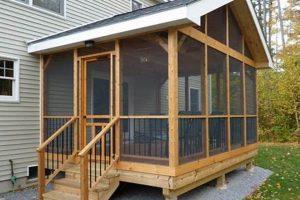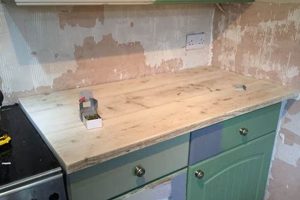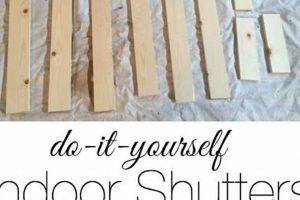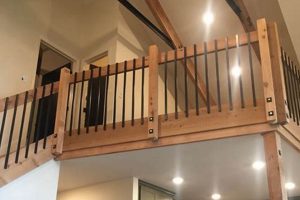The creation of shelters for birds using readily available materials allows for a personalized approach to avian conservation. The concept involves constructing secure and appropriately sized homes for various bird species to encourage nesting and reproduction in residential or natural environments. For instance, repurposing wood scraps into a bluebird house or transforming a gourd into a wren abode are practical examples.
Providing appropriate nesting locations can significantly contribute to local bird populations, offering protection from predators and harsh weather conditions, thus promoting biodiversity. Historically, offering constructed avian habitats has been a common practice, evolving from simple hollowed-out logs to more elaborate designs reflecting an increased understanding of bird behavior and habitat requirements.
The subsequent sections will delve into specific construction techniques, material selection criteria, size and placement considerations, and strategies for attracting birds to utilize these created spaces. The discussion will also encompass maintenance and cleaning protocols to ensure the longevity and continued usability of these avian shelters.
Construction and Placement Strategies
The following guidelines provide essential insights for maximizing the effectiveness of constructed avian habitats.
Tip 1: Material Selection: Opt for untreated, durable wood such as cedar, redwood, or pine. Avoid treated lumber due to potential toxicity to birds. Ensure that nails or screws used in assembly are rust-resistant to withstand weathering.
Tip 2: Entrance Hole Diameter: The size of the entrance hole directly influences the species that will inhabit the structure. Research appropriate dimensions for targeted bird species to prevent unwanted occupancy by larger, more aggressive birds such as starlings.
Tip 3: Drainage and Ventilation: Drill small drainage holes in the floor of the structure to prevent water accumulation. Provide ventilation holes near the roof to facilitate airflow and regulate internal temperature during warmer months.
Tip 4: Secure Mounting: Mount the finished structure securely to a tree, post, or building using appropriate hardware. Ensure that the structure is stable and will not sway excessively in windy conditions. Consider using predator guards to deter access by squirrels, raccoons, or snakes.
Tip 5: Placement Considerations: Place the structure in an area that offers adequate shelter from wind and rain. Orient the entrance hole away from prevailing winds. Consider the specific habitat preferences of the target bird species when selecting a location.
Tip 6: Regular Maintenance: Inspect the structure annually, ideally after the nesting season. Remove old nesting material to reduce parasite loads and maintain hygiene. Repair any damage to ensure continued structural integrity.
Adhering to these construction and placement strategies will improve the likelihood of attracting birds and providing them with safe and productive nesting environments.
The final section will summarize key considerations and offer suggestions for further resources.
1. Wood Type
The selection of wood type in the context of constructing avian shelters directly impacts the structure’s longevity, insulation properties, and overall suitability for nesting birds. The choice of material determines the nesting box’s resistance to weathering, decay, and potential toxicity. Consequently, the wood type represents a foundational element in the success of any shelter-building endeavor.
For example, untreated cedar is a preferred choice due to its natural resistance to rot and insects, minimizing the need for chemical treatments that could harm birds. Pine, while more affordable, requires greater consideration regarding thickness and sealing to prevent rapid degradation. Conversely, treated lumber, although durable, contains chemicals that can leach into the nesting environment, potentially causing harm to developing birds. Therefore, understanding the specific characteristics of each wood type is crucial for ensuring a safe and sustainable avian habitat. Consider the geographic location and typical weather conditions when choosing the wood as well.
In summary, wood type is not merely a structural component but a determinant of the shelter’s functional lifespan and the safety of its inhabitants. By prioritizing untreated, durable options, builders can effectively mitigate potential risks and provide a secure environment for nesting birds. Careful consideration of this factor is paramount in creating avian shelters that contribute positively to local ecosystems.
2. Entrance Hole Size
The dimensions of the entrance aperture represent a critical determinant in the species of bird that will utilize a constructed avian shelter. Precise control over this dimension allows for the targeted attraction of specific birds while simultaneously deterring larger, more aggressive species from occupying the space.
- Species-Specific Attraction
Different bird species necessitate varying entrance hole diameters to facilitate entry while maintaining security from predators and competitors. For example, a 1 1/2 inch hole is suitable for attracting Eastern Bluebirds, while a smaller 1 1/8 inch hole will favor smaller birds like wrens and chickadees. These dimensions are derived from empirical observation of bird behavior and habitat preferences.
- Predator Exclusion
The size of the entrance hole can also mitigate predation risk. While not a complete deterrent, a smaller opening makes it more difficult for larger predators, such as squirrels or raccoons, to access the nest and its contents. This is particularly relevant in urban or suburban environments where these animals are prevalent.
- Competitive Exclusion
Non-native or invasive species, such as the European Starling, can outcompete native birds for nesting resources. Starlings require larger entrance holes than many native species. Therefore, designing with appropriately sized openings can significantly reduce the likelihood of starling occupancy, thereby benefiting native bird populations.
- Nest Box Microclimate
The size of the entrance, while primarily for access, also influences the internal microclimate of the nesting box. Larger openings may increase ventilation, which can be beneficial in warmer climates but detrimental in colder regions. Consideration of local climatic conditions is therefore necessary when determining appropriate dimensions.
Effective design of avian shelters necessitates careful consideration of the entrance hole size in relation to target species, predation risk, and competitive exclusion. By tailoring this dimension to specific ecological contexts, individuals can increase the utility of
the shelters for promoting local biodiversity.
3. Drainage Adequacy
Adequate drainage within a constructed avian shelter is a crucial, yet often overlooked, design consideration that directly influences the habitability and longevity of the structure. The presence of excess moisture can lead to nest rot, fungal growth, and hypothermia in young birds, thereby reducing the shelter’s effectiveness and potentially harming its inhabitants.
- Preventing Nest Rot
Accumulation of rainwater or condensation within the nesting box fosters an environment conducive to fungal and bacterial growth, leading to the decomposition of nesting materials. This results in an unsanitary environment for developing birds and can attract insects or parasites. Drainage holes, typically small apertures in the floor of the structure, facilitate the removal of excess moisture, thereby inhibiting nest rot and maintaining a drier, healthier nesting environment. For instance, a nest box constructed without drainage holes can quickly become waterlogged after a rainfall, rendering it unusable and potentially harmful to any occupants.
- Regulating Humidity Levels
Excessive humidity within the nesting box can impede thermoregulation, particularly for young birds lacking fully developed plumage. A damp environment increases the risk of hypothermia, especially during cooler periods. Effective drainage, coupled with ventilation, promotes airflow and reduces internal humidity, assisting birds in maintaining a stable body temperature. Consider the placement of the nesting box to allow natural airflow that will assist in keeping the interior dry.
- Extending Structural Lifespan
Prolonged exposure to moisture accelerates the decay of wooden nesting boxes. Trapped water saturates the wood, promoting fungal growth and weakening the structural integrity of the shelter. Adequate drainage mitigates this issue by preventing water from pooling within the structure, thereby extending its lifespan and reducing the need for frequent repairs or replacements.
- Facilitating Nest Sanitation
Proper drainage aids in the natural removal of waste products and debris from the nesting box. Liquids and small particles can be flushed out through the drainage holes, contributing to a cleaner and more hygienic environment for the birds. This reduces the accumulation of potentially harmful substances and minimizes the risk of disease transmission within the nesting box.
The integration of effective drainage solutions into the design of constructed avian shelters directly impacts their habitability, longevity, and overall contribution to avian conservation efforts. Neglecting this aspect can lead to significant drawbacks, undermining the intended purpose of providing safe and productive nesting locations. Therefore, drainage adequacy warrants careful consideration during the planning and construction phases of any shelter-building project.
4. Mounting Security
Secure attachment constitutes a fundamental requirement for any avian shelter designed to withstand environmental forces and prevent premature dislodgement, thereby ensuring continuous habitability for nesting birds. The stability of the structure directly influences its attractiveness to birds and its effectiveness in providing a safe haven for raising offspring. Failure to adequately secure a nesting box compromises its functionality and potentially endangers its inhabitants.
- Resistance to Wind and Weather
Nesting boxes, particularly those exposed to open areas, are subject to considerable wind loads. A securely mounted structure minimizes swaying or detachment during high winds, preventing nest disturbance and reducing the risk of structural damage. Examples include using sturdy brackets or lag screws to attach the box to a tree trunk or post, ensuring a firm connection that can withstand substantial forces. Inadequate mounting can lead to the box being blown down, resulting in nest failure and the loss of young birds.
- Protection from Predators
A loosely mounted nesting box provides opportunities for predators to access the nest. Unstable structures may allow predators to rock or shake the box, dislodging eggs or fledglings. Secure mounting can deter climbing predators, such as squirrels or raccoons, by preventing them from gaining a foothold. For example, using smooth metal flashing beneath the mounting brackets can create a barrier that is difficult for climbing animals to navigate. Improper installation can render the shelter vulnerable to predation, negating its intended protective function.
- Structural Integrity and Longevity
Secure mounting contributes to the overall structural integrity of the nesting box, prolonging its lifespan. A stable structure experiences less stress and strain on its joints and materials, reducing the likelihood of premature wear and tear. Examples include using rust-resistant hardware and ensuring that the mounting surface is sound and stable. Inadequate mounting can lead to structural failure, requiring costly repairs or replacement of the nesting box.
- Minimizing Disturbance to Birds
Excessive movement or instability of the nesting box can disturb nesting birds, causing them to abandon the nest. A securely mounted structure minimizes such disturbances, providing a stable and predictable environment. This is particularly important during critical stages of nesting, such as egg laying and incubation. For example, using rubber washers or shims can reduce vibrations and further stabilize the box. Unsecured installations can result in nest abandonment, reducing the reproductive success of the birds.
The facets of mounting security underscore its importance in the construction of effective avian shelters. Secure attachment is not merely a mechanical consideration but a fundamental aspect of creating a safe, stable, and long-lasting environment for nesting birds. By prioritizing secure mounting practices, individuals can significantly enhance the utility of these nesting boxes and contribute positively to avian conservation efforts.
5. Location Appropriateness
The strategic placement of constructed avian shelters represents a critical determinant in their utilization and success. Selecting a location congruent with the ecological requirements of the target bird species maximizes the likelihood of occupancy and fosters reproductive success. This is a fundamental aspect when realizing do-it-yourself avian shelter concepts.
- Habitat Matching
Different bird species exhibit preferences for specific habitat types, ranging from open fields to dense forests. Placement of an avian shelter in a mismatched environment diminishes its attractiveness. For instance, a bluebird house positioned within a heavily wooded area will likely remain unoccupied, as bluebirds prefer open habitats with short grasses for foraging. Conversely, a wren house placed in a highly exposed location lacks the protective cover that wrens seek. Matching the habitat to the species requ
irements is paramount. - Proximity to Resources
The availability of essential resources, such as food and water, directly influences the suitability of a location. Avian shelters situated near natural food sources, such as berry-producing shrubs or insect-rich areas, are more likely to be utilized. Similarly, proximity to a clean water source enhances the attractiveness of the location. Consideration of these factors is essential during site selection, ensuring that the birds’ basic needs are met.
- Protection from Predators
The placement of avian shelters should prioritize protection from predators. Locating the structure in an area with limited access for climbing predators, such as squirrels or raccoons, reduces the risk of nest depredation. Additionally, avoiding locations near areas frequented by avian predators, such as hawks or owls, minimizes the risk to adult birds and fledglings. Strategic placement can significantly enhance the safety and security of the nesting environment.
- Minimizing Human Disturbance
Excessive human activity can deter birds from utilizing avian shelters. Locations near high-traffic areas, such as walkways or playgrounds, are less desirable due to the potential for frequent disturbances. Selecting a more secluded location, away from direct human contact, allows birds to nest undisturbed. This is especially critical during the sensitive period of incubation and chick-rearing, where disturbances can lead to nest abandonment.
These considerations emphasize that avian shelter construction is only one facet of successful avian conservation. Skillful placement, grounded in an understanding of species-specific needs and ecological factors, is equally vital. Integrating these principles ensures that DIY avian shelter endeavors contribute effectively to supporting local bird populations. Additional attention to microclimates can further tailor the location for optimal use.
6. Predator Deterrents
The integration of predator deterrents represents a critical component in the successful implementation of do-it-yourself (DIY) nesting box initiatives. These deterrents mitigate the risk of predation, a primary cause of nesting failure in birds, thereby increasing the likelihood of successful breeding and recruitment into local populations. The absence of effective predator deterrents can render a nesting box a death trap, negating the intended benefits of providing shelter.
Effective predator deterrents span a range of physical barriers and design modifications. Examples include the use of metal or plastic baffles mounted below the nesting box to prevent climbing predators, such as squirrels and raccoons, from accessing the entrance. Entrance hole restrictors, appropriately sized for the target bird species, prevent larger predators from entering the box. Some designs incorporate extended roof overhangs or recessed entrances, providing additional protection from avian predators. The effectiveness of each deterrent varies depending on the local predator community and the specific nesting box design. For instance, a conical baffle may be effective against climbing mammals but offer no protection against snakes or avian predators. A nesting box designed with smooth, slippery materials can also discourage climbing predators.
The inclusion of predator deterrents in DIY nesting box construction represents a proactive approach to avian conservation. While no deterrent is foolproof, their implementation significantly reduces the risk of predation, thereby enhancing the value of these structures as effective breeding sites. Overlooking this aspect can result in wasted effort and, potentially, increased mortality rates for the targeted bird species. Therefore, a thorough understanding of local predator pressures and the appropriate application of deterrent strategies are essential for maximizing the conservation impact of DIY nesting box projects.
7. Maintenance Schedule
The implementation of a structured maintenance schedule is inextricably linked to the long-term efficacy of do-it-yourself (DIY) nesting boxes. The absence of regular maintenance diminishes the intended benefits of providing supplemental avian habitat, potentially transforming the structure into a detrimental factor for bird populations. A consistent maintenance schedule addresses issues related to hygiene, structural integrity, and parasite control, each of which directly affects nesting success.
Neglecting maintenance results in the accumulation of old nesting material, facilitating the proliferation of parasites such as mites and fleas. These parasites can weaken or kill nestlings, reducing the reproductive output of the birds utilizing the shelter. Furthermore, unremoved nesting material may harbor fungal spores or bacteria, creating an unsanitary environment detrimental to avian health. Structurally, weather-induced damage can compromise the nesting box’s integrity, rendering it susceptible to predator intrusion or collapse. For example, a nesting box with a cracked roof can expose nestlings to rain and cold, leading to mortality. Adherence to a maintenance schedule, typically involving annual cleaning and repair post-nesting season, mitigates these risks. This entails removing old nesting material, sanitizing the interior, and addressing any structural damage, ensuring the shelter remains a safe and productive nesting location.
In summation, integrating a maintenance schedule into DIY nesting box endeavors is not merely an ancillary task but an essential component of avian conservation. Diligence in this regard maximizes the benefits of providing supplemental habitat, fostering healthy bird populations and promoting biodiversity. Failure to prioritize maintenance undermines the effort invested in constructing the shelter, potentially resulting in unintended negative consequences for the targeted bird species.
Frequently Asked Questions
The following questions address common concerns and misconceptions regarding the construction and deployment of avian nesting boxes, emphasizing practical considerations for maximizing their effectiveness.
Question 1: What is the optimal timing for installing a nesting box?
Installation prior to the nesting season, typically in late winter or early spring, provides birds with ample time to locate and acclimate to the structure before breeding commences. Specific timing varies by geographic location and target species.
Question 2: How high above ground should a nesting box be positioned?
Recommended height varies depending on the species. Generally, placement between 5 and 15 feet above ground offers adequate protection from ground predators while remaining accessible for monitoring and maintenance. Consult species-specific guidelines for optimal height.
Question 3: Is it necessary to provide nesting material inside the box?
It is generally not advisable to provide nesting material. Birds exhibit specific preferences for nest construction, and the provision of inappropriate materials may deter occupancy or introduce harmful substances. The birds will bring their own materials.
Question 4: How frequently should a nesting box be cleaned?
Annual cleaning following the nesting season is recommended. Removal of old nesting m
aterial reduces parasite loads and maintains hygienic conditions for subsequent broods. More frequent cleaning is unnecessary and may disrupt nesting activities.
Question 5: What steps can be taken to discourage non-native species from occupying the box?
Selecting appropriate entrance hole sizes, specific to the target native species, effectively excludes larger, more aggressive non-native birds such as European Starlings. Consistent monitoring and, if necessary, nest removal can further deter unwanted occupancy.
Question 6: How can one determine if a nesting box is actively in use?
Observational cues such as frequent visits by adult birds carrying nesting material or food indicate active use. Avoid disturbing the box during nesting periods; observe from a distance to minimize stress on the birds.
Adhering to these guidelines will improve the success of nesting box initiatives and contribute to the well-being of local bird populations.
The following section summarizes crucial considerations for DIY nesting boxes.
DIY Nesting Box Ideas
The preceding exploration of “diy nesting box ideas” has underscored the critical considerations involved in constructing effective avian shelters. Strategic material selection, entrance hole sizing, drainage implementation, secure mounting, appropriate location, predator deterrence, and consistent maintenance schedules each contribute to the success or failure of such endeavors. A comprehensive understanding of these elements, coupled with species-specific knowledge, informs the creation of safe and productive nesting environments.
Continued diligence in applying these principles is paramount. The construction of avian shelters represents a tangible commitment to biodiversity conservation, requiring informed action and ongoing stewardship. The collective impact of thoughtfully implemented nesting box initiatives can significantly contribute to the well-being of local bird populations, fostering ecological resilience in an increasingly challenging world. It requires an individual to consider their dedication towards providing and upkeeping avian shelters.







